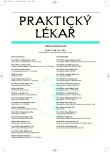Combination drug therapy for hypertension
Authors:
sr. J. Widimský
Authors‘ workplace:
Přednosta: prof. MUDr. Vladimír Staněk, CSc.
; Přednosta: prof. MUDr. Josef Kautzner, CSc.
; Subkatedra kardiologie IPVZ, Praha
; Klinika kardiologie, IKEM Praha
Published in:
Prakt. Lék. 2007; 87(9): 525-529
Category:
Various Specialization
Overview
A combination of various sorts of antihypertensive drugs offers an additive blood pressure lowering effect and reduces the risk of side effects that are dependent on antihypertensive drug dose. Since hypertension control in the Czech Republic and worldwide is not satisfactory, and a target BP is attained in only 5–30 % of patients, it is necessary to extend the use of combined hypertension treatment. Monotherapy can only help attain a target BP in 10–25 % of patients. Compliance with monotherapy without reaching the target BP puts patients at risk of cerebrovascular and cardiovascular complications. Combined treatment is indicated in:
a) all hypertonic patients with a systolic BP that is >0.20 mmHg above target level or diastolic BP that is >10 mmHg higher than the target level,
b) patients with diabetes mellitus (target levels are 130/80 mm Hg,
c) patients with critical organ impairment;
d) patients with renal or cardiovascular disease (patients with IHD, patients after a cerebrovascular event).
Fixed combinations are more comfortable for patients (requiring them to take fewer pills); however their main advantage is that they often reduce the dose of individual anti-hypertensive drugs. The hitherto favourite double combination of a thiazide diuretic and a beta blocker is not suitable for patients with metabolic syndrome and in patients at risk of diabetes, because it impairs glucose metabolism. Combinations containing doses of thiazide diuretic higher than 25 mg are also unsuitable, the optimal dose of hydrochlorothiazide is 12.5mg. Combinations of 2 antihypertensives of the same sort are inappropriate. A combination of antihypertensive and a hypolipidemic treatment is also very effective. The article offers a survey of suitable double, triple and quadruple combinations of antihypertensive drugs, and reviews fixed combinations of hypertensive drugs available on the Czech market.
Key words:
combined treatment of hypertension, fixed combination, indications of combined treatment
Labels
General practitioner for children and adolescents General practitioner for adultsArticle was published in
General Practitioner

2007 Issue 9
Most read in this issue
- Hypotermia as an injury, illness, symptom
- Induratio penis plastica – diagnostics and treatment
- Calcium score assessment combined with myocardial perfusion stress test by single photon tomography (SPECT). Two case studies.
- Hantaviruses and related diseases in the Czech Republic
